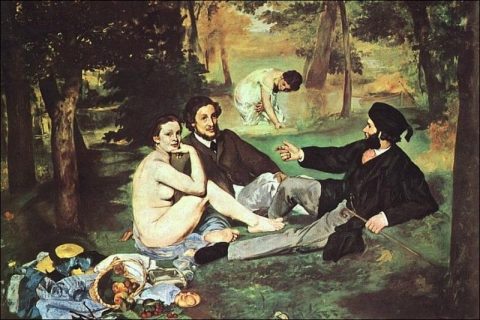Interested in art about Éduard Manet, which represents a breaking point in the history of European painting almost everyone knows a few things. Most importantly today has the birth of modern art is the leading position. Scenes of Manet from everyday life with thick contours and raw colors in a way, it shakes the academy tradition in France. Especially from the Renaissance Hz. Jesus’ spirituality that embraces all humanity,
The mercy of the Virgin Mary, the miracle of the stories of creation, the power of Zeus, the beauty of Venus and its appeal, the magnificent lives of the nobility, the beautiful kings and queens, which always look fresh and alive fruity still lifes, that is, all the elements reflecting the glorious period of art history in the 19th century Finally, he begins to be questioned by a revolutionary painter in Paris. So Manet’s the form he adopted was taken aback by the audience looking at the canvas.
However, when we look at the major revolutions and breaking points in the history of art, an artist’s traditional It is thought that it destroys form patterns and develops a unique form understanding. Because the audience is accustomed to different styles begin to replace the forms of representation. For example, in art since the 20th century realism, romance, cubism, abstract, expressionism etc. started to be seen in art history writing.
These currents of art, each of which seemed to have left each other behind, were categorized on a formal basis are handled by separating from each other. However, this decomposition is not only the work of art, but also the artist. it is only to handle the form by subjecting it to a change. Actually the question of what art is. This problem art that contains it only as a form of material and technique it may be against the assessment error. For this reason, an important representative of modern art such as Manet to identify only with terms like “strange” and “extraordinary” that he brought to art history. is to ignore the philosophical and psychological dimension in his art.
Of course, populist art is the habit of evaluating the work by first looking at its formal features. It has to offer. For this reason, for years, Picasso has been “the man who made pictures such as children We describe. Whereas Picasso said, “It took me four years to paint like Rafael. Picture like a child being able to do all my life ”is the philosophy, worldview, emotions, content so focusing on the spirituality that is about the subject is the first thing that comes to mind of those who talk about art Could not be.
Manet can be considered as another representative of this example. Hall exhibition in 1863. “Lunch on the Grass”, which was rejected by the artist, on the formal basis of many art history reading. made by reference. Because of the costume, two apparently French bourgeoisie the woman sitting naked in the middle of the man and staring directly at the audience,
It was something new and strange that the audience saw. Especially this audience is French who experienced the 19th century modernity. When he became a member of his society, things started to get more complicated. The noble painting tradition of academism. The bourgeoisie who lived, suddenly threw Manet into criticism for this immoral picture that came across them. So much so that even a “Hall of Rejection” was opened for those who approached Manet and his unconventional style. But all these developments were directed towards the formal aspect of the art understanding that Manet had adopted. However, only formal patterns that make Manet and “Lunch on the Grass” important for modern art not to be destroyed.
Who is the woman who looks at us in the picture? What impression do we make? Naked Is it a value that prevents all these questions? Or because we are aware of your nudity? are we annoyed by the gaze? When we think of these questions around the philosophical context of modern art, another picture emerges. This time there is Manet starring. How Does?
It is not independent of the creator of the artwork and its historical and social context. Artist, reflects his belonging to his work during creation. What we’re trying to see behind the form is the artistic personality of its creator. Manet, 19th century Europe in this woman who is staring at the audience. It contains the social structure and the dissolution of traditional art with its modernity.
Changing As the witness of the world, Manet looks at the audience for his thoughts on all this social transformation. is the subject of the woman figure. Thus, Manet is now a trace left in the artwork. Official. It is also the subject who watches the picture and who looks at us from the picture. All that makes modern art possible this is the individualization underlying the displacement in the object relationship with the audience.
Hits: 771
